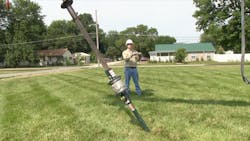When utility crews are dealing with the aftermath of storms, they cannot forget to evaluate how the guy anchors have been impacted. Rebuilding the overhead lines depends more than ever on the holding capacity of the guy anchor.
Here are a few things to consider when inspecting utility lines after a storm:
1. If flooding has caused ground water levels to rise, the anchors may not hold as much load as they did when they were originally installed.
2. Ground water rise can reduce anchor holding capacity by as much as 50% when the water table rises above the anchor plates.
3. Erosion of the overburden soil above the anchor can result in reduced capacity and possibly anchor creep (movement).
Utility crews can do a few things when repairing utility lines after a storm.
- Re-tension the guy. If anchor continues to creep, a new anchor or additional anchor will be needed.
- Install a new anchor as a replacement or as additional capacity.
- If the original anchor is a square shaft (SS) anchor, adding additional extension will drive the helical lead section deeper into the ground. Crews should continue to drive the anchor until reaching the torque needed to support the load. This work should only be performed by trained professionals.
To achieve the full capacity of an anchor, follow these guidelines:
- The top helix of anchor should be approximately five feet vertically below ground surface.
- When installing more than one anchor for a pole, they must be separated by approximately five feet.
- Install the anchor in line with the guy to reduce damage to the anchor-rod as a result of the anchor-rod bending.

